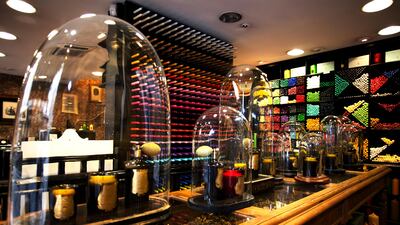"We weren't sure most people would get it or even know what to do with them," says Julien Pruvost, the executive director of the luxury candlemaker, Cire Trudon. "I used to play with stink bombs as a kid so it made complete sense to me - even if it's meant that some people have just thought we're crazy."
Stink bombs - small vials of typically pungent-smelling liquid, usually let off by naughty children as a practical joke - are not what one might expect from a company founded in 1643 and which supplied candles to France's royal court. However, the Cire Trudon version, offered in six fragrances and designed to emanate a glorious perfume to fill every corner of a room, is just one of the latest innovations introduced by this esteemed and historic French company.
"You have to have some humour when you're being creative today," Pruvost says of the stink bombs. "Candles are, at heart, simple products, just natural wax, cotton wick, glass, so they need to have a twist."
Cire Trudon makes scented candles for Hermès, Cartier, Dior and Guerlain, in addition to its own, lesser-known, line. However, after an overhaul of the company, overseen by Pruvost, a former Gucci executive, the company is about to claim a much higher profile, beginning with the opening of its first stand-alone shop in Paris.
To underline its historical pedigree, the company has also made a return to its traditional, artisan roots, including the reinstatement of some 17th-century production techniques. The candles' containers are now exclusively made by Italian master glassmakers.
Alongside this, the company has redesigned its packaging, using witty illustrations by the artist Lawrence Mynott, designing candles in unusual shapes - slowly melting busts of Marie-Antoinette and Napoleon have already become bestsellers - with fragrances inspired by their names.
Among these are Ernesto (inspired by the Cuban revolutionary Che Guevara), Dada (after the surrealist art movement) and Odeur de Lune, based on the imagined smell of the moon.
While the home fragrance market has typically been marketed at women, Cire Trudon's unisex packaging and scent names have prompted growing interest among men - in line, Pruvost suggests, with the booming male-grooming market.
Scented candles are "now suddenly a huge market", Pruvost says. For the likes of Jo Malone and Fornasetti, candles are easy brand extensions. Their battery-free simplicity appeals in a technological world, and candles remain one of the best fragrance-delivery systems. Although Pruvost points out that scented candles are typically misused, with many people failing to understand that they need only be burnt for as long as is necessary to melt a pool of wax and emit the scent.
The surge is also due to a modern householder encouraged to develop an arguably excessive interest in hygiene and cleanliness, of which a sweet-smelling home may be a reflection. Perhaps this is even a throwback to the 17th-century origin of demand for scented candles, when masking the pongs of poorly ventilated homes without sewerage systems was a genuine need.
"But now scented candles are about representation, too," Pruvost reflects. "They have become status objects well beyond their function of quietly flickering in the corner. If you just want to get rid of a bad smell, you use an air freshener. But a constant and sophisticated fragrance has become a reflection of how you want your home to be perceived - they provide a home with an identity. That appeal may be largely unconscious, but it is catching."
Certainly, as well as private-label manufacturing, Cire Trudon is increasingly involved in creating signature fragrances for retail and hospitality businesses. One client is London's Claridges hotel, which is using scent to create not only a sense of homeliness - providing something that guests can instinctively recognise on repeat visits - but as much part of its brand as its logo or letterheads.
So-called "olfactory marketing" is becoming big business - the likes of Singapore Airlines, Rolls-Royce, Sony, De Beers, Barnes & Noble and, most recently, Visa have all used aroma as part of their brand strategies.
Just such innovation is also on Cire Trudon's agenda for its next products. There is a new fragrance due out next spring. The company is also working on using new technology to deliver fragrance, whether through a USB stick, or a home system that could be remotely activated by email, as well as how to give an upmarket spin to in-car air fresheners.
"You have to be careful when developing such products because they can seem gimmicky and there is a brand image to protect - we don't do tea-lights, for example," says Pruvost. "But we're certainly keen to take great scents into new environments and in interesting ways."

